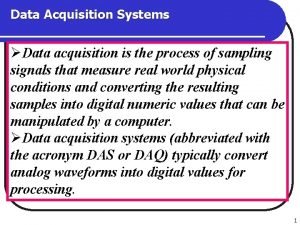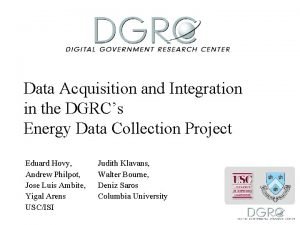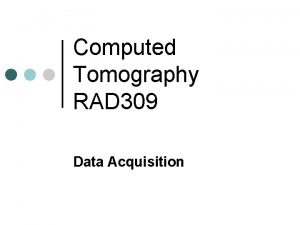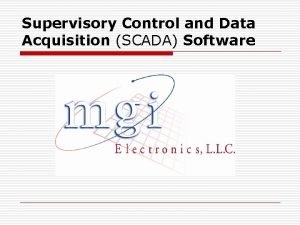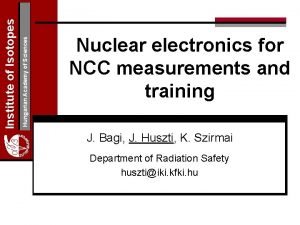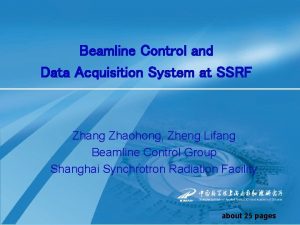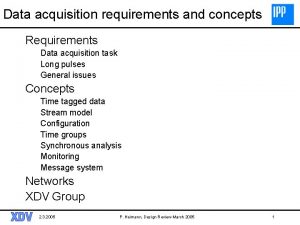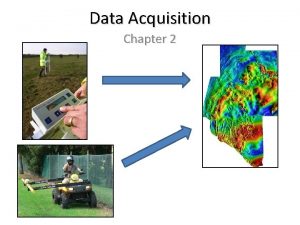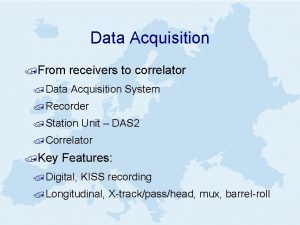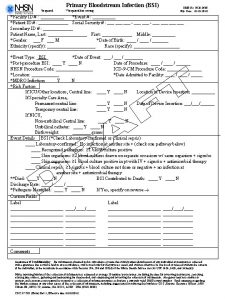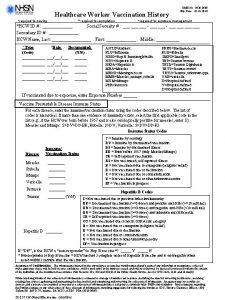DAS Data Acquisition Systems A DAS is required




























- Slides: 28

DAS: Data Acquisition Systems • A DAS is required to allow an electronic system to get information on the external environment • The development of extremely miniaturized DASs capable of detecting a large number of different and inhomogeneous quantities is currently urged by emerging fields, such as robotics, security and health care. • This is giving a significant contribution to the request for analog and mixed signal integrated So. Cs • The design of a DAS involve architectures and specifications that recur in many other branches of analog and mixed signal microelectronic circuits. P. Bruschi – Microelectronic System Design 1

The electronic system and the enviroment P. Bruschi – Design of Mixed Signal Circuits 2

Main blocks of an Electronic System DAS (full acquisition operations) P. Bruschi – Microelectronic System Design 3

Elements of a DAS: a two-channel case P. Bruschi – Microelectronic System Design 4

Signal classification on the basis of quantization Magnitude Time P. Bruschi – Microelectronic System Design 5

DAS estimation errors Identity (ideal DAS) Actual value of the Input quantity (as measured by the Reference instrument) Total error (input referred) Output stream of estimated values In d. c Is the input offset P. Bruschi – Microelectronic System Design 6

Sensitivity factors 0 1 2 j 3 4 i P. Bruschi – Microelectronic System Design 7

Block diagram of the DAS with error sources and a few sensitivities P. Bruschi – Microelectronic System Design 8

Input referred contribution corresponding to an error source Input referred (RTI) contribution of exi P. Bruschi – Microelectronic System Design 9

Effect of non-linear response on the RTI error Even a simply addittive error may give an RTI error that depends on the value of the input quantity smaller k larger RTI error larger k smaller RTI error P. Bruschi – Microelectronic System Design 10

Error on dependent quantities P. Bruschi – Microelectronic System Design 11

Error on Angular Quantities Y V q X P. Bruschi – Microelectronic System Design 12

Error on angular quantities P. Bruschi – Microelectronic System Design 13

Type of errors • Quasi static: offset, gain, non-linearity These errors are nearly constant when the input quantity is constant (their variation is much slower than the system time-constant) • Dynamic errors These errors are caused by the system finite speed of response and are absent when the input quantity is constant • Noise The error caused by noise is always present, time varying and random. Only the statistical properties of noise are known. The mean value of noise is zero. P. Bruschi – Microelectronic System Design 14

Quasi-static errors: offset Output offset Input offset P. Bruschi – Microelectronic System Design 15

Quasi static errors: Gain error The gain error can be easily defined for linear systems. If the system is non-linear, we can refer to a linear approximation. For a linear system, nominally: In a real system: -Xe-gain If k. X-real is unknown, we must use the nominal gain (k. X-nom) to Estimate Xm from Vxi-real P. Bruschi – Microelectronic System Design 16

Quasi static errors: Gain error • The result of the gain error (xe-gain) is proportional to the input quantity (it is not an addittive error) • To estimate the result of the gain error we must take into account the relative gain error Dk/k Design approaches to reduce the gain error: • Make transfer functions as much as possible dependent on ratios of omogeneous quantities. These ratios are minimally sensitive to process errors and temperature. • The number of non-dimentionless quantities that should appear in the transfer function should be as small as possible and these quantities should be related to precision components or adjustable components. P. Bruschi – Microelectronic System Design 17

Ratiometric systems In a ratiometric system, the sensitivity is proportional to the supply voltage Vdd. k. X In this way the need of a precise and stable VREF for the ADC is removed VX P. Bruschi – Microelectronic System Design 18

Non-linearity errors • Generally the maximum non linearity error in the whole range of the input quantity X is indicated in the secifications • If the non-linear curve is well reproducible, the non-linearity error can be compensated for by means of a non-linear estimator. • For random non-linearities, individual multi-point trimming is necessary. P. Bruschi – Microelectronic System Design 19

Dynamic errors Settling time tset: Time required to have the output voltage stay close to the final value within a given relative error Typical error specs: 1 % (low accuracy) 0. 01 % (high accuracy) P. Bruschi – Microelectronic System Design 20

Linear time and slew-rate time Linear-time only (all stages behave linearly) Slew-rate only (most of the transition time at least one stage is saturated) P. Bruschi – Microelectronic System Design 21

Noise Xn-pp If we sample the output Signal Xm, then the standard Deviation of the samples is: Cf= crest factor 1 - probability Interval Total interval width Probability (xnp-p) ±s 2 s 0. 683 (68. 3 %) 0. 317 ± 2 s 4 s 0. 954 (95. 4 %) 0. 046 ± 3 s 6 s 0. 997 0. 003 ± 4 s 8 s 0. 999936 (99. 7 %) (99. 9936 %) P. Bruschi – Microelectronic System Design 6. 4 10 -5 22

Noise and resolution Samples in this range are compatible with both the X and X+DX input. Therefore, it is not guaranteed that a difference DX can be recognized X Transition X X+DX The minimum difference that can be detected (resolution) Involve noise bands in contact but with null intersection. P. Bruschi – Microelectronic System Design 23

Detection limit The detection limit xdl is the minimum value of the input quantitity that can be distinquished from a zero input. max(|xio|)+ For X=0 xdl xn-pp 2 max(|xio|) vio can be anywhere in This band 0 -max(|xio|) -[ max(|xio|)+ xn-pp 2 Total uncertainty band ] P. Bruschi – Microelectronic System Design 24

The Dynamic Range (DR) Signal range dx can be: Xmax-Xmin=XFS Xmin Full scale (excursion) 1. The resolution (most frequent case) 2. The detection limit 3. The maximum total error (combination of offset + noise + non-linearity) P. Bruschi – Microelectronic System Design 25

DR and maximum number of significant levels Xmax Let us consider that d. X is the System resolution Number of distinguishable levels = DR XFS The presence of noise cause a sort of quantization of the analog signal, at least in terms of usable levels Fist level that the system can distinguish from Xmin dx Xmin P. Bruschi – Microelectronic System Design 26

Dynamic range of a cascade of blocks (series connection) P. Bruschi – Microelectronic System Design 27

DR in series-connected blocks P. Bruschi – Microelectronic System Design 28
 Second language acquisition vs foreign language acquisition
Second language acquisition vs foreign language acquisition Single channel and multichannel data acquisition system
Single channel and multichannel data acquisition system Acquisition
Acquisition Test stand data acquisition systems
Test stand data acquisition systems Data acquisition and data analysis
Data acquisition and data analysis What is data acquisition in data warehouse
What is data acquisition in data warehouse Pmt 0140 team management and leadership
Pmt 0140 team management and leadership Hydraulic data required for bridge design
Hydraulic data required for bridge design Aq1 aphis data may be required
Aq1 aphis data may be required Verifies that a required field contains data.
Verifies that a required field contains data. Plc data acquisition
Plc data acquisition Spatial data acquisition
Spatial data acquisition Spatial data acquisition
Spatial data acquisition Digital data acquisition system block diagram
Digital data acquisition system block diagram Data acquisition and integration
Data acquisition and integration Data acquisition form nadra
Data acquisition form nadra Data acquisition and integration
Data acquisition and integration Mass spectrometry data acquisition for gc/ms
Mass spectrometry data acquisition for gc/ms Data acquisition system in ct scan
Data acquisition system in ct scan Supervisory control software
Supervisory control software Nuclear data acquisition
Nuclear data acquisition Data acquisition plan
Data acquisition plan Data acquisition chicago il
Data acquisition chicago il Data acquisition in ct
Data acquisition in ct Data acquisition
Data acquisition Data acquisition
Data acquisition Adc simultaneous sampling
Adc simultaneous sampling Remote data acquisition
Remote data acquisition Das alte ist vergangen das neue angefangen
Das alte ist vergangen das neue angefangen













